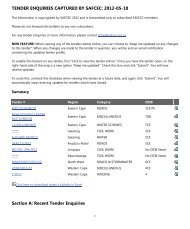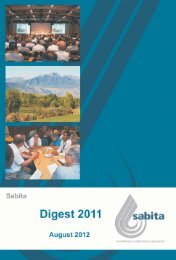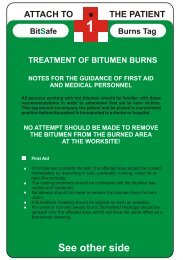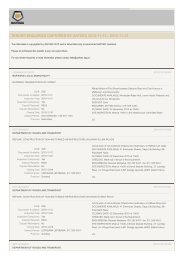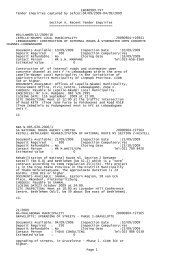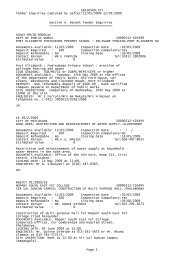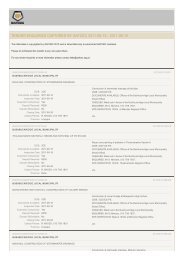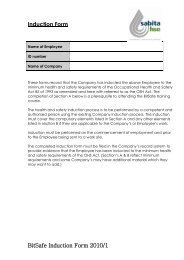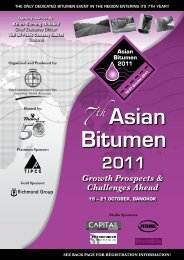DIGEST 2006 - Sabita
DIGEST 2006 - Sabita
DIGEST 2006 - Sabita
You also want an ePaper? Increase the reach of your titles
YUMPU automatically turns print PDFs into web optimized ePapers that Google loves.
Bond coats<br />
Bond coats were first used with<br />
the introduction of the integrated<br />
paver/sprayers for application of<br />
Ultra Thin Friction Course (UTFC)<br />
asphalt in South Africa in 1999.<br />
These thin, open graded asphalt<br />
layers are placed at an average<br />
thickness of 18mm. The strains<br />
induced by traffic at the surface/<br />
binder interface are much greater<br />
than the forces acting on the<br />
thicker asphalt layer/binder<br />
interfaces, and undiluted rapid<br />
setting cationic polymer modified<br />
emulsions are thus used for this<br />
purpose to ensure adequate bond<br />
strength at the interface.<br />
The thin asphalt<br />
surfacing layer and<br />
the bond coats are<br />
usually offered as<br />
an integral package<br />
by the applicators.<br />
The paving unit<br />
applies the binder<br />
uniformly using a<br />
calibrated,<br />
computer<br />
controlled, spraying<br />
system. In the case<br />
of simultaneous application, the<br />
free water in the emulsion bond<br />
coat foams when it comes into<br />
contact with the hot mix asphalt.<br />
The reduced viscosity of the<br />
foamed binder and its subsequent<br />
expansion allows the binder to<br />
penetrate more effectively into the<br />
existing substrate and overlying<br />
mix, thus creating an improved<br />
bond.<br />
Application rate of the bond coat<br />
varies typically between 0,4 – 0,6<br />
l/m 2 depending mainly on the<br />
Deformation<br />
proceeds<br />
at a faster<br />
rate when<br />
a proper bond<br />
has not been<br />
created<br />
substrate texture, leaving a<br />
residual modified binder<br />
application of 0,26 to 0,39 l/m 2 ,<br />
which is considerably higher than<br />
the residual binder content used<br />
for the conventional, thicker<br />
asphalt lifts. The thicker residual<br />
binder layers also provide better<br />
waterproofing, as the thinner,<br />
open graded asphalt layers are<br />
more prone to allowing water<br />
infiltration compared to the<br />
conventional, dense layers.<br />
Specific requirements<br />
• High softening point of<br />
residual binder to prevent<br />
excessive migration into the<br />
open UTFC<br />
aggregate<br />
structure under<br />
traffic after<br />
paving;<br />
• Very rapid<br />
setting<br />
characteristics.<br />
The UTFC layer is<br />
very thin and<br />
rapidly cools<br />
down after<br />
paving. During<br />
the time interval<br />
when the mat is at a<br />
temperature in excess of<br />
100 0 C, most of the water in<br />
the emulsion should boil off.<br />
The emulsion should be<br />
sufficiently de-stabilised<br />
during this short period to<br />
prevent re-emulsification,<br />
which could occur if<br />
unexpected rain falls on the<br />
surface within the first few<br />
minutes after paving;<br />
• Despite the rapid setting<br />
characteristics required of a<br />
bond coat, the emulsion<br />
131



